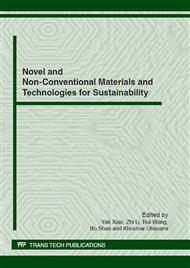[1]
J.Z. Xiao, He. Xie, Chang-qing. Wang, Gang. Li, Statistical Analysis on Building Waste in Wenchuan Earthquake-hit Area, Journal of Sichuan University (Engineering Science Edition). 41(3) (2009) 188-194. (in Chinese).
Google Scholar
[2]
J.Z. Xiao, Jiabin Li, Ch. Zhang, Mechanical properties of recycled aggregate concrete under uniaxial loading, Cement and Concrete Research. 35 (2005) 1187-1194.
DOI: 10.1016/j.cemconres.2004.09.020
Google Scholar
[3]
J.M. Khatib, Properties of concrete incorporating fine recycled aggregate, Cement and Concrete Research. 35 (2005) 763-769.
DOI: 10.1016/j.cemconres.2004.06.017
Google Scholar
[4]
J.Z. Xiao, Lan Yang, Jia-bin. Li, Jun-long. Wang, A review on long-term properties of recycled aggregate concrete, Structural Engineers. 21(3) (2005) 73-76. (in Chinese).
Google Scholar
[5]
V.M. Malhotra, Use of recycled concrete as a new aggregate, report 76-18, Canada Centre for Mineral and Energy Technology, Ottawa, Canda, (1976).
Google Scholar
[6]
K. Amnon, Properties of concrete made with recycled aggregate from partially hydrated old concrete, Cement and Concrete Research. 33(5) (2003) 703- 711.
DOI: 10.1016/s0008-8846(02)01033-5
Google Scholar
[7]
J.S. Ryu, An experimental study on the effect of recycled aggregate on concrete properties, Magazine of Concrete Research. 54 (1) (2002) 7- 12.
DOI: 10.1680/macr.2002.54.1.7
Google Scholar
[8]
H.J. Chen, T. Yen, K.H. Chen, Use of building rubbles as recycled aggregates, Cement and Concrete Research. 33 (2003) 125-132.
DOI: 10.1016/s0008-8846(02)00938-9
Google Scholar
[9]
S. Wild, J.M. Khatib, M. O'Farrell, B.B. Sabir, S.D. Addis, The potential of fired brick clay as a partial cement replacement material, In: R.K. Dhir, T.D. Dyer (Eds. ), International Conference—Concrete in the Service of Mankind: Concrete for Environment Enhancement and Protection, Dundee, 24–28 June, 1996, p.685.
Google Scholar
[10]
J.M.V. Gómez-Soberón, Porosity of recycled concrete with substitution of recycled concrete aggregate: An experimental study, Cement and Concrete Research. 32(2002) 1301-1311.
DOI: 10.1016/s0008-8846(02)00795-0
Google Scholar
[11]
M.A. Serrano-López, Creep and shrinkage of recycled aggregate concrete, Construction and Building Materials. 23 (2009) 2545-2553.
DOI: 10.1016/j.conbuildmat.2009.02.018
Google Scholar
[12]
W. Wang, L. Liu, L. Shang, L. Wang, Study on recycled aggregate concrete, China Concrete and Cement Product. 8 (2001) 9-12. (in Chinese).
Google Scholar
[13]
H. Wu, S. Song, Study on recycled aggregate concrete durability, Chinese Ready-Mixed Concrete. 4(2006) 25-30. (in Chinese).
Google Scholar
[14]
Z. Cui, Y. Ohaga, M. Kitatsuji, R. Tanka, Durability test on the recycled aggregate concrete, Chinese Journal of Science Technology and Engineering. 6(23) (2006) 4801–4805. (in Chinese).
Google Scholar
[15]
H.A. Mesbah, Efficiency of polypropylene and metallic fibers on control of shrinkage and cracking of recycled aggregate mortars, Constructions and Building Materials. 27(8) (1999) 439-447.
DOI: 10.1016/s0950-0618(99)00047-1
Google Scholar
[16]
N. Otsuki, S. Miyazato, W. Yodsudjai, Influence of recycled aggregate on interfacial transition zone, strength, chloride, penetration and carbonation, Journal of Materials in Civil Engineering. 15(5) (2003) 443-451.
DOI: 10.1061/(asce)0899-1561(2003)15:5(443)
Google Scholar
[17]
T. Hiroshi, N. Atsushi, O. Junichi, I. Keiichi, High quality recycled aggregate concrete processed by decompression and rapid release, ACI Special Publications. (2001).
DOI: 10.14359/10597
Google Scholar
[18]
A. Shayan, A. Xu, Performance and properties of structural concrete made with recycled concrete aggregate, ACI Materials Journal. 100(5) (2003) 371-380.
DOI: 10.14359/12812
Google Scholar
[19]
M.C. Limbachiya, T. Leelawat, R.K. Dhir, Use of recycled concrete aggregate in high-strength concrete, Materials and Structures. 33(10) (2000) 574-580.
DOI: 10.1007/bf02480538
Google Scholar
[20]
C.F. Hendriks, The use of concrete and masonry waste as aggregates for concrete production in the Netherlands, EDA/RILEM demo-recycling conference. Proc. II"re-use of concrete and brick materials". Rotterdam, European Demolition Association, Wassenaarseweg 80, 2596 CZ Den Haag, the Netherlands, 3 June (1985).
DOI: 10.1007/978-94-009-3663-8_54
Google Scholar
[21]
T.M. Witesides, H.S. Sweet, Effect of mortar saturation in concrete freezing and thawing testing, Proceedings of Highway Research Board. 30 (1950) 204-216.
Google Scholar


